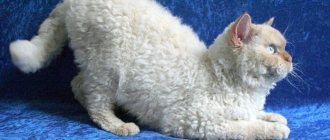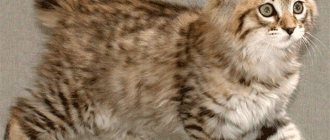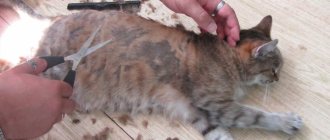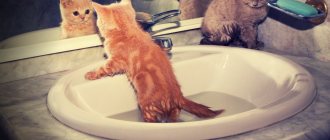History of the origin of the breed
Unexpectedly for herself, a certain English baroness of German origin acted as the “fairy godmother” of a new breed of Burmilla cats back in 1981 - and all because of her own careless maid, who neglected to look after her mistress’s Burmese cat, one of whose entertainments was a German woman. -baroness, there was breeding of cats of Persian and, as is already clear, Burmese breeds.
One day that year, the baroness planned to present her “familiar friend” with a Persian cat of chinchilla color, and he, that is, this very “familiar friend” of the baroness, in turn, was going to immediately castrate him. The cat, as if immediately sensing something was wrong, quickly fled from the unjust reprisal to the backyard of the baroness’s estate, where he accidentally found (that very happy accident!) the above-mentioned tailed fugitive - a cat of the Burmese breed.
The cat clearly rose to the occasion at that time: while the essence and the matter, while the “sweet couple” came to their senses, they “happened” to have a sudden love, after which, after the allotted time, charming babies were born, distinguished by their easy-going character, large yellow-greenish eyes and wool of an unusual color - with a silvery tint.
As a result, the happy owner of both pets and their newborn hybrid offspring made a wise decision to keep and continue to breed cats with a similar color and character, and even came up with a name for the new breed - Burmilla, which was derived from the name of the mother's breed, the Burmese cat, and the chinchilla color of the cat -manufacturer.
Description of the breed with photographs
For some reason, photographs with images of short-haired individuals of this breed - the Burmilla cat breed - are the most widely circulated on the World Wide Web. Probably because the breed standard requires short hair. Although, along with short-haired cats, long-haired Burmilla cats are no less famous, widespread and even more popular.
According to unverified rumors, representatives of both species may appear in one litter.
Exterior or shorthair
- The animal's head is of medium size, without any sharp transitions - say, from the forehead to the nose.
- The muzzle with noticeable cheeks is somewhat larger in cats than in cats.
- The ears have a slight forward slope and are of medium size.
- The eyes are dark-rimmed, large, oriental in shape, widely spaced.
- The nose is pink, rather small.
- The body is well-muscled, graceful, proportional.
- The feet are of medium length, described as powerful, and topped with black pads.
Longhair
Everything is the same as what was just described above, with the exception of the fur itself - this time long.
Varieties of colors
Currently, there are different variations or, more correctly, standards for the following colors of Burmilla cats:
- smoky,
- shaded,
- tabby - striped
- solid - homogeneous.
Burmilla character and behavior
Like any other domestic cat, the “average” (if, of course, such exist at all, for each cat has its own special character) Burmilla is a real aristocrat, unusually smart, well-mannered, affectionate and humane cat, extremely loyal and unobtrusive, which easily gets along with his brothers and other animals.
Cats and Burmilla cats are unpretentious to their living conditions and are easy to train; they are equally happy in a city apartment or a country house, as long as their beloved two-legged one is always nearby.
Due to its extreme attachment to humans, the Burmilla categorically does not accept loneliness and really misses its owner if he is absent for a long time, and therefore these cats, like cats in general, should not and are not even recommended to have as a pet people who are forced to leave home for a long time, going on, for example, a long work trip.
The charming, big-eyed Burmilla are completely devoid of aggressiveness and are quite loyal to small children - they never allow themselves to let out their claws or, say, bite a child. This statement is true both for cats of this breed and for male cats.
And the Burmilla is an incorrigible chatterbox cat who undoubtedly loves to “chat” about this and that, to tell her loving owner about what she saw and knows what happened to her during the day while he was not around; she is playful, but, we repeat, in no way unobtrusive, she is pleased, it is vital for her to constantly interact with a person, but she herself can occupy herself with what she loves most in the world - playing with her own toys. Having played enough, she lies down to rest, as she should from above, curled up in a ball.
Health
The genes of the Persian ancestors played a cruel joke only in the fact that Burmillas are susceptible to polycystic kidney disease. Cysts that can form in this organ theoretically lead to kidney failure, but in practice, with proper care and nutrition, kidney problems can be avoided.
How to determine polycystic disease in a pet? Clinical symptoms are lethargy, decreased appetite, frequent urge to go to the toilet, and weight loss.
But a blood test and x-ray can identify the problem and make an accurate diagnosis.
There are no other genetic diseases observed in cats, so the Burmilla can be called a long-lived cat.
The life expectancy of charming Englishmen is 15-18 years. Most importantly, do not forget to carry out preventive anthelmintic procedures and drive away fleas.
Care
Caring for a Burmilla cat is minimal. The animal's fur is of such excellent quality that it is enough to just brush your pet once a week.
Train your Burmilla to have its ears cleaned weekly.
Most Burmillas have an extremely negative attitude towards nail trimming, so the best solution would be a scratching post or claw pads.
Clean ears, neat manicure, well-groomed coat... What does a Burmilla look like? Like a beauty from a beauty salon!
Feeding
Feeding your Burmilla correctly is very easy. The main rule is not to overfeed. Because for a miniature cat, the price for losing her figure is great moral suffering.
But in general, the food is standard, as for all cats. Do not offer milk to an adult Englishwoman; she may love it, but she does not digest it in the literal sense of the word. It’s better to treat your Burmilla to dairy products more often.
Video
Breeders' homes
Photos
If you highlight the differences between Burmillas and kittens of other breeds, then you should focus on the shape of the muzzle. Have you noticed that Burmilla always smile? This makes them look great in photos!
Maintenance and care
Like any other pet, be it a Labrador or a white rat, Burmilla cats require basic care.
Care
The concept of “care” in the case of cats implies a whole range of hygienic measures, starting from bathing once a quarter at most, combing their fluffy fur coat and ending with periodic examination of their ears to identify possible infection with a special type of ear mite - otodecosis. The first, however, applies more to exhibition specimens, which are bathed somewhat more often than just mentioned, five to six times a year using special shampoos.
A separate article is the care of the pet’s claws, which are usually trimmed or, more precisely, slightly shortened on average every one and a half to two weeks, as well as the oral cavity (hygiene) and eyes of the animal.
For more detailed information and advice on each of these points, it makes sense and is even strongly recommended to contact the relevant sources on the Internet and relevant specialists - veterinarians.
Feeding
Like cats of any other breed or even outbred mestizos, Burmilla cats are fed according to their age: kittens three to four times a day, adults twice a day, morning and evening.
Natural products
Adequate nutrition presupposes the presence of animal protein, and therefore in the diet of cats in general, and in the daily diet of Burmilla cats in particular, lean meat, and along with it amino acids and, of course, vitamins, should account for no less than 80% of the total volume all their food. And this is beef, rabbit, poultry, finally.
By the way, fish is not very suitable for adding to the daily diet of all domestic cats, no matter how paradoxical it may sound, and raw fish is simply contraindicated, strictly prohibited due to possible diseases of the kidneys and genitourinary system of these animals.
The remaining 20% are vegetables, cereals, eggs, milk - the latter, by the way, is more suitable for kittens rather than adults.
Of course, your pet should be accustomed to all this literally “from a young age” and in no case should you overfeed him - for example, neutered cats do not know how to eat in moderation and this often leads to excessive vomiting, and at best, to obesity - at worst.
Recommended food
Certified dry and wet food from well-known premium and super-premium manufacturers, which you should never skimp on in order to avoid the most unpleasant consequences for your pet’s health.
Walk
Despite all their “hopeless domesticity,” Burmillas really need regular walking, and this is worth doing, first of all, for the sake of keeping your beloved pet in good physical shape. It is clear that each such “going out” should be accompanied by the owner, and the cat (or tom) should be taken outside strictly on a harness - only in clear, not rainy and warm weather.
It is also clear that before the start of the walking season, the animal must be properly prepared - treated in advance against parasites and vaccinated.
Care and feeding
Burmillas, especially short-haired ones, do not require special care. These cats should only be washed when necessary. Long-haired dogs require a little more attention - they need to be brushed 1-2 times a week.
The beautiful eyes of the Burmilla also need to be monitored and cared for. Crusts and discharge that accumulate in the inner corners of the eyes can be carefully removed with a cotton swab soaked in saline solution, a weak decoction of plantain or a 3% solution of boric acid.
Ears also need constant inspection by the owner for mites and brown plaque.
Feed should be premium food or natural food. The main menu for adults consists of lean boiled meat (turkey, rabbit, chicken, beef) and fermented milk products (low-fat cottage cheese, yogurt and yogurt without additives). You can also sometimes include pureed apples or carrots and fish in your diet, but it is better not to feed them seafood.
What you should not feed your Burmilla:
- pork;
- mutton;
- onion and garlic;
- eggplant;
- sweets;
- smoked meats.
How to choose and where to buy a kitten
There are special breed nurseries in some large cities of our country - we note at the same time that this breed in Russia is currently not very widespread.
When conducting transactions of this kind, it is mandatory to have a purchase and sale agreement, a passport of the future pet with a pedigree, veterinary certificates of vaccination and vaccinations and other related documents.
Ideally, the choice of a child should be made in the presence of a specialist, at the age of 10 - 12 weeks of age, and the baby itself should be clean and well-groomed, without bald spots and other defects, the possible presence of which the breeder is simply obliged to warn the potential buyer.
Nurseries
Currently, only one nursery specializing in the reproduction and breeding of Burmilla cats is registered on the World Cat Federation website - Chatburdeoa, located in the city of Serpukhov, Moscow region.
Breed cost
It all depends on where the child was purchased - in a club or nursery the price will be noticeably higher than from a private breeder. For some individuals with a pedigree, but without any exhibition prospects, they may ask for 30,000 rubles.
Buying a Burmilla cat
The price for kittens of this unusual breed may vary depending on the requirements of the breeder, who invests a lot of effort and money into breeding healthy and attractive kittens.
On average, they ask for from 25,000 to 50,000 rubles. Cats that qualify for participation in exhibitions based on their external characteristics will cost more.
1111











